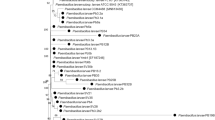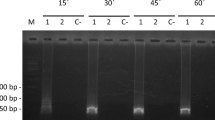Abstract
American foulbrood (AFB), a severe bacterial disease of honeybee brood, has recently been found in Uruguayan apiaries. Detection of the causative agent, Paenibacillus larvae subspecies larvae, is a very important concern in order to prevent disease dissemination and decrease of honey production. Since spores are the infective forms of this pathogen, in the present work we report the use of polymerase chain reaction (PCR) to detect P. l. subsp. larvae spores from in vitro cultures, larvae with clinical symptoms and experimentally contaminated honey. The set of primers was designed based on the published P. l. subsp. larvae 16S rRNA gene. Using this approach we could amplify the pathogen DNA and obtain a great sensitivity and a notable specificity. Detection limit for spore suspension was a 10−2 dilution of template DNA obtained from 32 spores, as determined by plate count. For artificially contaminated honey, we could detect the PCR product at a 10−3 dilution of template DNA obtained from 170 spores. In addition, when PCR conditions were set to improve specificity, we were able to amplify P. l. subsp. larvae DNA selectively and no cross-reactions were observed with a variety of related bacterial species, including P. l. subsp. pulvifaciens. Since spore detection is very important to confirm the presence of the disease, this method provides a reliable diagnosis of AFB from infected larvae and contaminated honey in a few hours.
Similar content being viewed by others
References
Alippi, A.M. 1992 Characterization of Bacillus larvae White, the causative agent of American foulbrood of honey-bees. First record of its occurrence in Argentina. Revista Argentina de Microbiología 24, 67–72.
Alippi, A.M. 1995 Detection of Bacillus larvae spores in Argentinean honeys by using a semi-selective medium. Microbiología SEM 11, 343–350.
Dobbelaere, W., de Graaf, D.C., Peeters, J.E. & Jacobs, F.J. 2001a Comparison of two commercial kits for biochemical characterization of Paenibacillus larvae in the diagnosis of AFB. Journal of Apicultural Research 40, 37–40.
Dobbelaere, W., de Graaf, D.C., Peeters, J.E. & Jacobs, F.J. 2001b Development of a fast and reliable diagnostic method for American foulbrood disease (Paenibacillus larvae subsp. larvae) using a 16S rRNA gene based PCR. Apidologie 32, 363–370.
Govan, V.A., Allsopp, M.H. & Davison, S. 1999 A PCR detection method for rapid identification of Paenibacillus larvae. Applied and Environmental Microbiology 65, 2243–2245.
Hansen, H. & Brødsgaard, C.J. 1999 American foulbrood: a review of its biology, diagnosis and control. Bee World 80, 5–23.
Herman, L.M., De Block, J.H.G.E. & Waes, G.M.A.V.J. 1995 A direct PCR detection method for Clostridium tyrobutyricum spores in up to 100 milliliters of raw milk. Applied and Environmental Microbiology 61, 4141–4146.
Heyndrickx, M., Vandemeulebroecke, K., Hoste, B., Janssen, P., Kersters, K., De Vois, P., Logan, N.A., Ali, N. & Berkeley, R.C.W. 1996 Reclassification of Paenibacillus (formerly Bacillus) pulvifaciens (Nakamura 1984) Ash et al. 1994, a later subjective synonym of Paenibacillus (formerly Bacillus) larvae (White 1906) Ash et al. 1994, as a subspecies of P. larvae, with amended description of P. larvae as P. larvae subsp. larvae and P. larvae subsp. pulvifaciens. International Journal of Systematic Bacteriology 46, 270–279.
Hornitzky, M.A.Z. & Nicholls, P.J. 1993 J medium is superior to sheep blood agar and brain heart infusion agar for the isolation of Bacillus larvae from honey samples. Journal of Apicultural Research 32, 51–52.
Katznelson, H. 1950 Bacillus pulvifaciens (n.sp.), an organism associated with powdery scale of honey-bee larvae. Journal of Bacteriology 59, 153–155.
Kolbert, C.P. & Persing, D.H. 1999 Ribosomal DNA sequencing as a tool for identification of bacterial pathogens. Current Opinion in Microbiology 2, 299–305.
McPherson, M.J. & Møller, S.G. 2000 PCR. The Basics: from Background to Bench. pp. 67–87. Springer-Verlag New York Inc. ISBN 0-387-91600-8.
Offce International des Epizooties (OIE) 1999 World Animal Health. ISBN 92-9044-531-9, pp. 606–607.
Piccini, C. & Zunino, P. 2001 American foulbrood in Uruguay: Isolation of Paenibacillus larvae subspecies larvae from larvae with clinical symptoms and adult honeybees, and susceptibility to oxytetraciclyne. Journal of Invertebrate Pathology 78, 176–177.
Sambrook, J., Fritsch, E.F. & Maniatis, T. 1989 Molecular Cloning: a Laboratory Manual. Cold Spring Harbor, NY: Cold Spring Harbor Press. ISBN 0-87969-309-6.
Stahly, D.P., Alippi, A.M., Bakhiet, N., Campana, C.F., Novak, C.C. & Cox, R. 1999 PPL1c, a virulent mutant bacteriophage useful for identification of Paenibacillus larvae subespecies larvae. Journal of Invertebrate Pathology 74, 295–296.
Wilson, I.G. 1997 Inhibition and facilitation of nucleic acid amplication. Applied and Environmental Microbiology 63, 3741–3751.
Author information
Authors and Affiliations
Rights and permissions
About this article
Cite this article
Piccini, C., D'Alessandro, B., Antúnez, K. et al. Detection of Paenibacillus larvae subspecies larvae spores in naturally infected bee larvae and artificially contaminated honey by PCR. World Journal of Microbiology and Biotechnology 18, 761–765 (2002). https://doi.org/10.1023/A:1020435703165
Issue Date:
DOI: https://doi.org/10.1023/A:1020435703165




